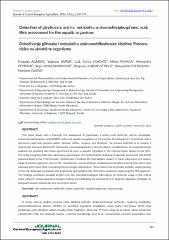Detection of glyphosate and its metabolite aminomethylphosphonic acid:Risk assessment for the aquatic organisms

View/
Date
2024Author
Agarski, Miroslav
Bursić, Vojislava
Vuković, Gorica
Puvača, Nikola
Petrović, Aleksandra
Konstantinović, Bojan
Ljubojević Pelić, Dragana
Cvetkovikj, Aleksandar
Ćurčić, Marijana
Metadata
Show full item recordAbstract
This paper delves into a thorough risk assessment of glyphosate, a widely used herbicide, and its metabolite,
aminomethylphosphonic acid (AMPA), within the aquatic ecosystems of the Danube-Tisa-Danube (DTD) network, which
represents large land drained system between Serbia, Hungary, and Romania. The primary objective is to employ a
Toxicity and Exposure Ratio (TER) framework, encompassing both acute and chronic considerations, to comprehensively
evaluate the potential risks these agrochemicals pose to aquatic organisms in the intricate hydro system of the DTD.
The study integrates field data, laboratory experiments, and mathematical modeling to quantify glyphosate and AMPA
exposure levels in the DTD channels. Furthermore, it explores the toxicological impacts of these substances on a diverse
range of aquatic organisms, such as fish, invertebrates, and amphibians, considering acute effects arising from short-term
exposure and chronic effects resulting from prolonged interactions. This research aims to provide a holistic understanding
of the risk landscape associated with glyphosate and AMPA in the DTD hydro system by employing the TER approach.
The findings contribute valuable insights into the potential ecological implications of herbicide usage in this critical
water network, aiding regulatory decision-making and facilitating the development of targeted mitigation strategies to
safeguard aquatic biodiversity and ecosystem health.
